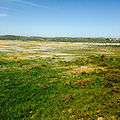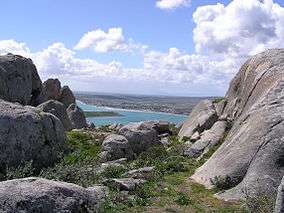West Coast National Park
| West Coast National Park | |
|---|---|
|
IUCN category II (national park) | |
|
Granite formations overlooking the Langebaan Lagoon | |
 Location of West Coast National Park | |
| Location | Western Cape, South Africa |
| Nearest city | Langebaan |
| Coordinates | 33°7′15″S 18°4′0″E / 33.12083°S 18.06667°ECoordinates: 33°7′15″S 18°4′0″E / 33.12083°S 18.06667°E |
| Area | 27,500 hectares (106 sq mi) |
| Established | 1985 |
| Governing body | South African National Parks |
| http://www.sanparks.org/parks/west_coast/ | |
The West Coast National Park lies 120 km (75 mi) north of Cape Town in the Western Cape province of South Africa. It is 27,500 hectares (106 sq mi) in size. It is bordered by the Atlantic Ocean on the west and the R27 coastal road, and runs from the town of Yzerfontein in the south up to the Langebaan lagoon. The park is particularly well known for its bird life and for the spring flowers which occur in the months from August to October, especially in the Postberg flower reserve section of the park. The park was proclaimed in 1985.[1] The park, with the islands in Saldanha Bay, has been identified by BirdLife International as an Important Bird Area.[2]
Fauna
Wildlife in the park includes large antelope such as eland, red hartebeest, bontebok, kudu, gemsbok, steenbok, mountain zebra, duiker and ostriches in the Postberg section. Other smaller animals include the bat-eared fox, caracal, and Cape gray mongoose.[3]
Many Palearctic migrants winter in the lagoon during the austral summer, particularly in September as species arrive from the northern hemisphere, and in March when they gather in large numbers to feed up prior to undertaking the return migration. At these times the birds will be transitioning out of and into their breeding plumage. The birds are pushed towards the hides as the water level rises with the tide and eventually they must fly off until the tide has receded once more. Red knot, sanderling, little stint, Ruff, marsh, Terek and Curlew sandpipers, ruddy turnstone, ringed and grey plover, greenshank, Eurasian whimbrel, Eurasian curlew and bar-tailed godwit are the most regular species. Little egret and South African shelduck are resident and can often be seen with the waders, while greater flamingoes and great white pelican occur in deeper water. An isolated hide west of the Geelbek educational centre overlooks a salt pan where it is possible to observe the rare chestnut-banded plover.[4] The lagoon's importance for migratory birds means that it is a site which is subject to the Ramsar Convention for the conservation and sustainable use of wetlands.[5]
On the land the fynbos surrounding the lagoon is home to Southern black korhaan, Cape spurfowl and grey-winged francolin, southern grey and Cape penduline tit, Southern ant-eating chat, white-throated and yellow canary, Karoo lark, chestnut-vented Tit-babbler, bokmakierie and cape bunting which are all easily seen. African marsh harrier and black Harrier hunt by quartering the ground. The coastal islands at the mouth of the lagoon are important breeding colonies for kelp and Hartlaub's gull, Cape gannet and African penguin, as well as cormorants and terns.[4]
Postberg
The months of August and September bring about the proliferation of annual Spring flowers in the West Coast National Park. Although the thousands of migrating birds are an important part of the conservation, the flowers are also a major attraction. The area of Postberg, where the carpets of flowers can be seen, is only open during these two Spring months. The most common flower species are: Suurvy (Carpobrotus edulis), Elandsvy (Carpobrotus acinaciformis), Gousblom (Arctotis hirsuta), Bokbaai vygie (Dorotheanthus bellidiformis), White rain daisy (Dimorphotheca pluvialis), Sporrie (Heliophila coronopifolia), Magriet (Ursinia anthemoides), and Soetuintjie (Moraea fugax). The park is composed of various kinds of vegetation – as well as the Langebaan fynbos and lagoon - that accounts for the variety of flora and fauna all around the park.[6]

Photo gallery

 Spring flowers
Spring flowers Dorotheanthus species
Dorotheanthus species A field of flowers in the park
A field of flowers in the park Geelbek Restaurant, West Coast National Park, Western Cape
Geelbek Restaurant, West Coast National Park, Western Cape Spring flowers in the Postberg area during August to September.
Spring flowers in the Postberg area during August to September. Spring flowers in the Postberg area during August to September.
Spring flowers in the Postberg area during August to September. Spring flowers in the Postberg area during August to September.
Spring flowers in the Postberg area during August to September. Spring flowers in the Postberg area during August to September.
Spring flowers in the Postberg area during August to September. Spring flowers in the Postberg area during August to September.
Spring flowers in the Postberg area during August to September. Spring flowers in the Postberg area during August to September.
Spring flowers in the Postberg area during August to September. Spring flowers in the Postberg area during August to September. A view from one of the roads up to the 'uitkyk'.
Spring flowers in the Postberg area during August to September. A view from one of the roads up to the 'uitkyk'. Spring flowers in the Postberg area during August to September.
Spring flowers in the Postberg area during August to September. View of the Langebaan Lagoon from the west side of the park.
View of the Langebaan Lagoon from the west side of the park. Spring flowers in the Postberg area during August to September.
Spring flowers in the Postberg area during August to September.
References
- ↑ Chittenden, Hugh (1992). Top Birding Spots in Southern Africa. Southern. p. 367. ISBN 1 86812 419 3.
- ↑ . "Important Bird Areas factsheet: West Coast National Park and Saldanha Bay islands.". BirdLife International. Retrieved 7 May 2012.
- ↑ "Mammals". South African National Parks. Retrieved 23 October 2016.
- 1 2 "Birding in West Coast National Park". South African National Parks. Retrieved 23 October 2016.
- ↑ "Langebaan". The Ramsar Convention Secretariat. Retrieved 23 October 2016.
- ↑ "SANParks | West Coast National Park - SANParks - Official Website". South African National Parks. Retrieved 2015-10-24.
External links
| Wikimedia Commons has media related to West Coast National Park. |
